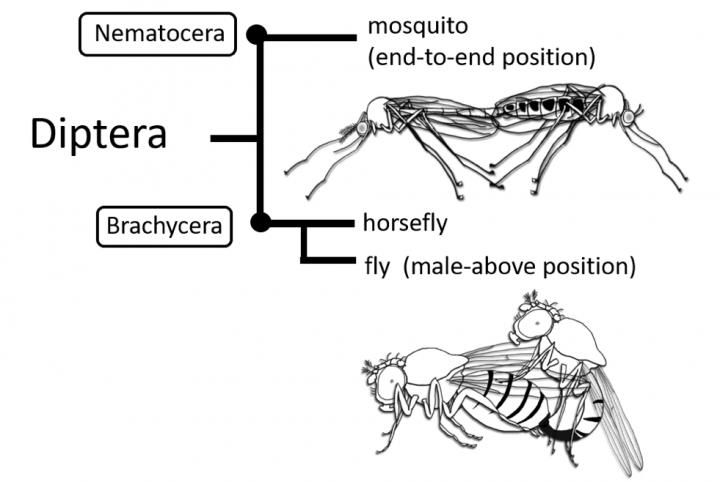Research at Osaka University on the angle of male flies’ genitalia suggests a cooperative evolution of body structure and behavior

Credit: © Inatomi M. et al. (2019) Scientific Reports 9:210
Osaka, Japan – In the order Diptera, more-primitive species such as mosquitos generally do their deed in the end-to-end position. Higher (more evolved) species such as flies tend toward the male mounting the female from behind (male-above position).
It’s nature’s infallibility at work: these positions are the most effective and productive alignment of the two sexes’ genitalia for the sake of successful reproduction.
The genitalia of healthy higher species rotate a full 360 degrees early in their development, compared with the 180-degree rotation of males in the lower species. Both rotations allow ideal accommodation of the respective positions. There are broader implications here in terms of how species’ morphology (shape) and behavior evolutionarily cooperate.
Researchers at Osaka University set out to test how rotation of certain dipterans’ genitalia related to their mating behavior and copulatory success, and thereby to how this rotation ties to evolution. They recently reported their findings in Scientific Reports.
The researchers studied Myo31DF mutant flies, in which the genitalia sometimes prematurely terminate their rotation. This choice provided them with subjects with the same genetic background, though with a range of genital directions, which was ideal for examining correlation of the genitalia angle with mating behaviors and reproductive outcomes. In controlled conditions, they used video monitoring to analyze how the dorsoventral (back-to-belly) direction of the males’ genitalia affected their courtship behaviors and sexual success.
“Males with genitalia that had larger angle deviations from proper dorsovental direction had notably lesser success at producing offspring,” study co-author Kenji Matsuno explains.
Thus, genital rotation to accommodate the best sexual position for reproductive success bolstered the hypothesis that morphology (in this case, genital adaptation) and behavior (sexual position) have evolved cooperatively. However, there were exceptions. Males with genitalia 45 degrees off the ideal still copulated successfully; the key was not the degree of rotation, but rather the dorsoventral direction.
Interestingly, courtship behaviors and copulation position did not significantly vary among males with various angles of genitalia. The males generally all went through the same motions. The main indicator of ultimate success was the dorsoventral direction.
“The findings reaffirm that the male-above position evolved cooperatively with the additional 180-degree genital rotation from the ancestral end-to-end position, and that an insufficient angle can negatively affect reproduction,” study first author Momoko Inatomi says. “This is valuable from an evolutionary perspective, and we may be able to apply this finding for practical uses, such as pest control.”
###
The article, “Proper direction of male genitalia is prerequisite for copulation in Drosophila, implying cooperative evolution between genitalia rotation and mating behavior” was published in Scientific Reports at DOI: https:/
Media Contact
Saori Obayashi
[email protected]
Original Source
https:/
Related Journal Article
http://dx.




